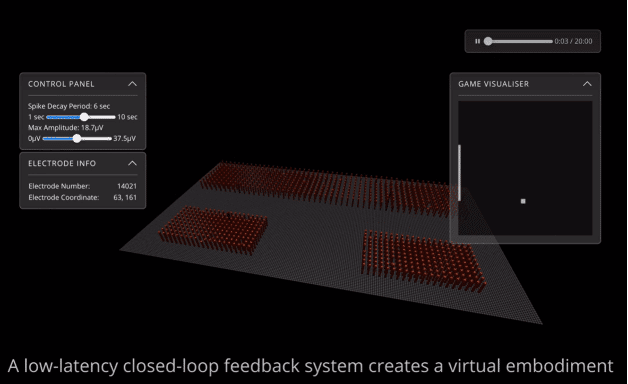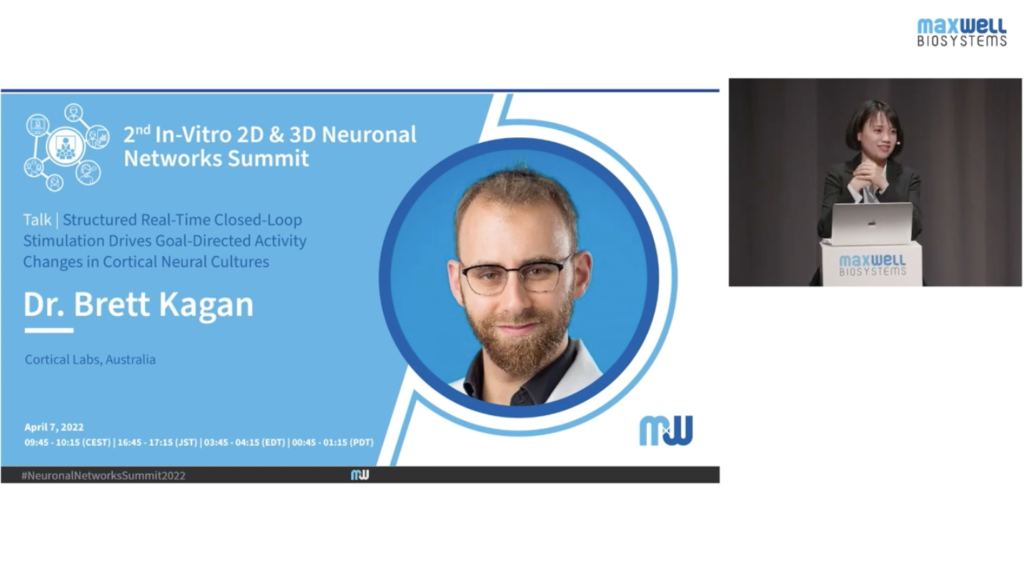MxW Interview with Brett Kagan
Cortical Labs, Melbourne, Australia
Recently, we had the pleasure of having Dr. Brett Kagan from Cortical Labs visiting us here in the MaxWell Biosystems HQ in Zurich and hosting an exciting seminar on their recent work and progress.
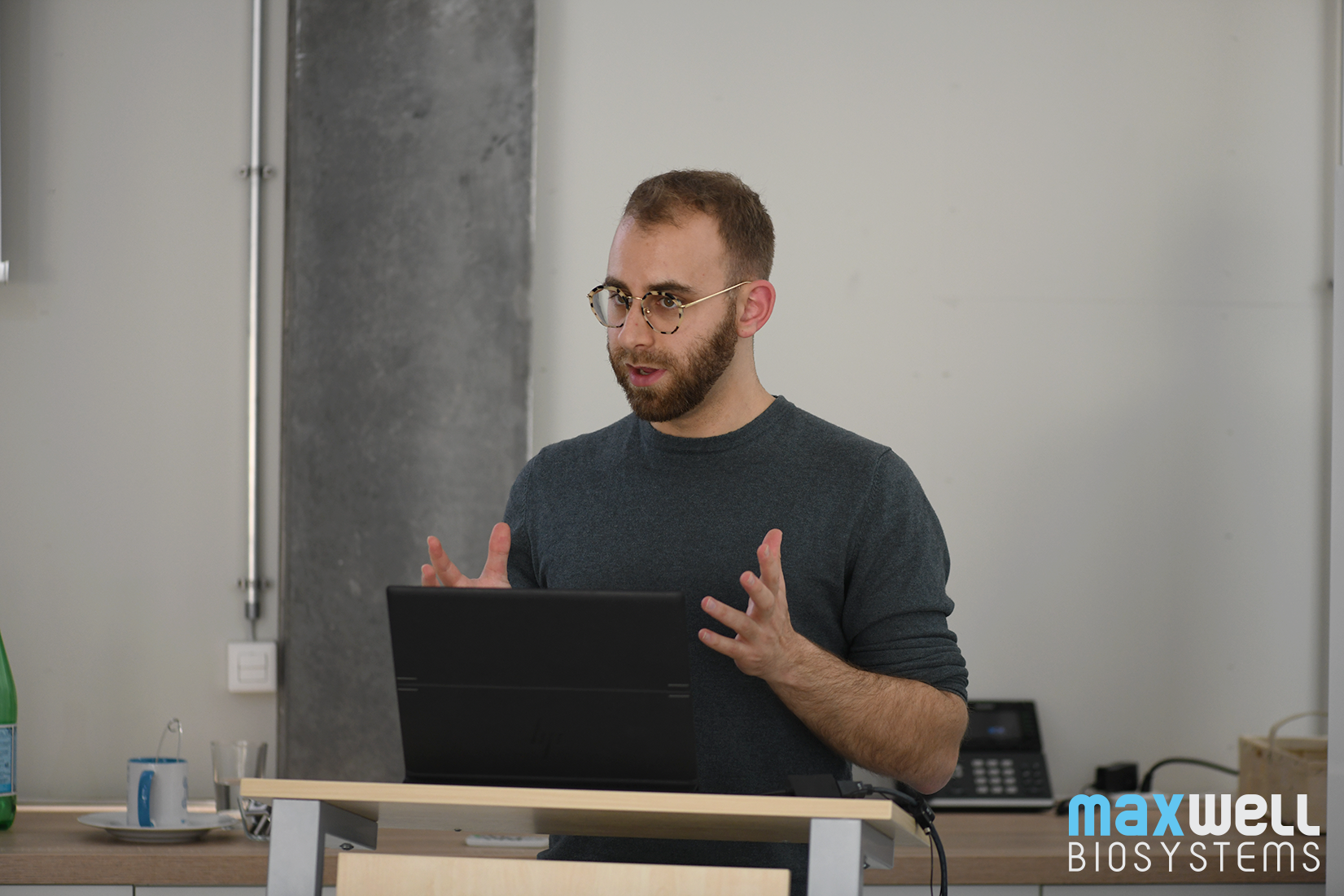

Brett Kagan speaking at MaxWell Biosystems, Switzerland
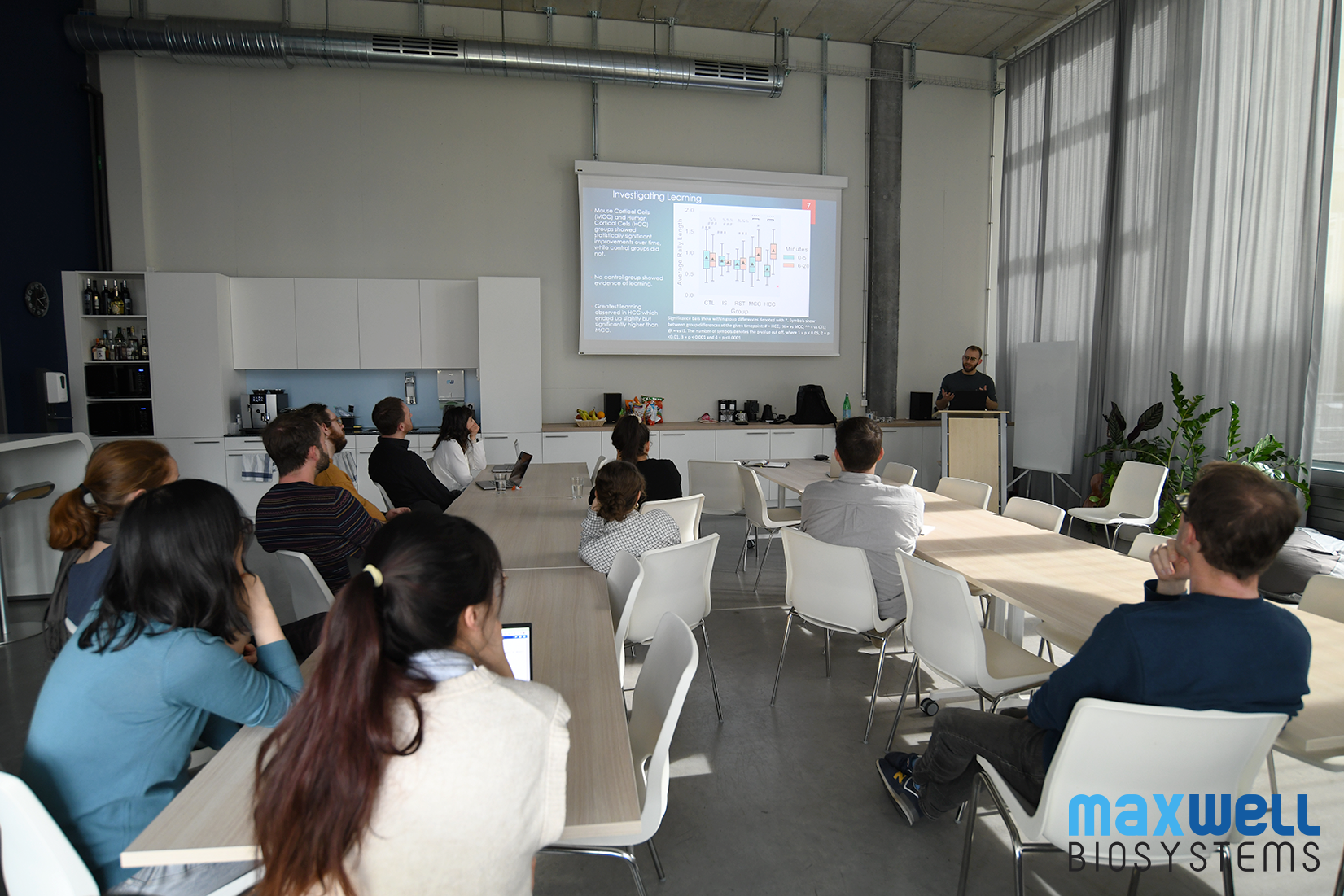

Brett Kagan speaking to the MaxWell Biosystems team during his seminar
Dr. Brett Kagan’s latest work on training brain cells to play Pong using HD-MEAs, published in Neuron (Kagan et al, Neuron, 2022), became viral last year, and we had the opportunity to learn more about this study, hear about the next steps, and discuss his research and its impact.
Read the interview with Dr. Brett Kagan bellow:
How did MaxWell Biosystems HD-MEA’s products power the start of your journey in Cortical Labs?
I think one really nice thing about MaxWell Biosystems CMOS approach is that it gave us a lot of flexibility to try out different configurations and allowed us to pattern out how we wanted to read and stimulate the cells.
When you start out, there is a lot of variation when plating down cells, and being able to be flexible in what areas of the chip you are reading is indeed very useful and helpful.
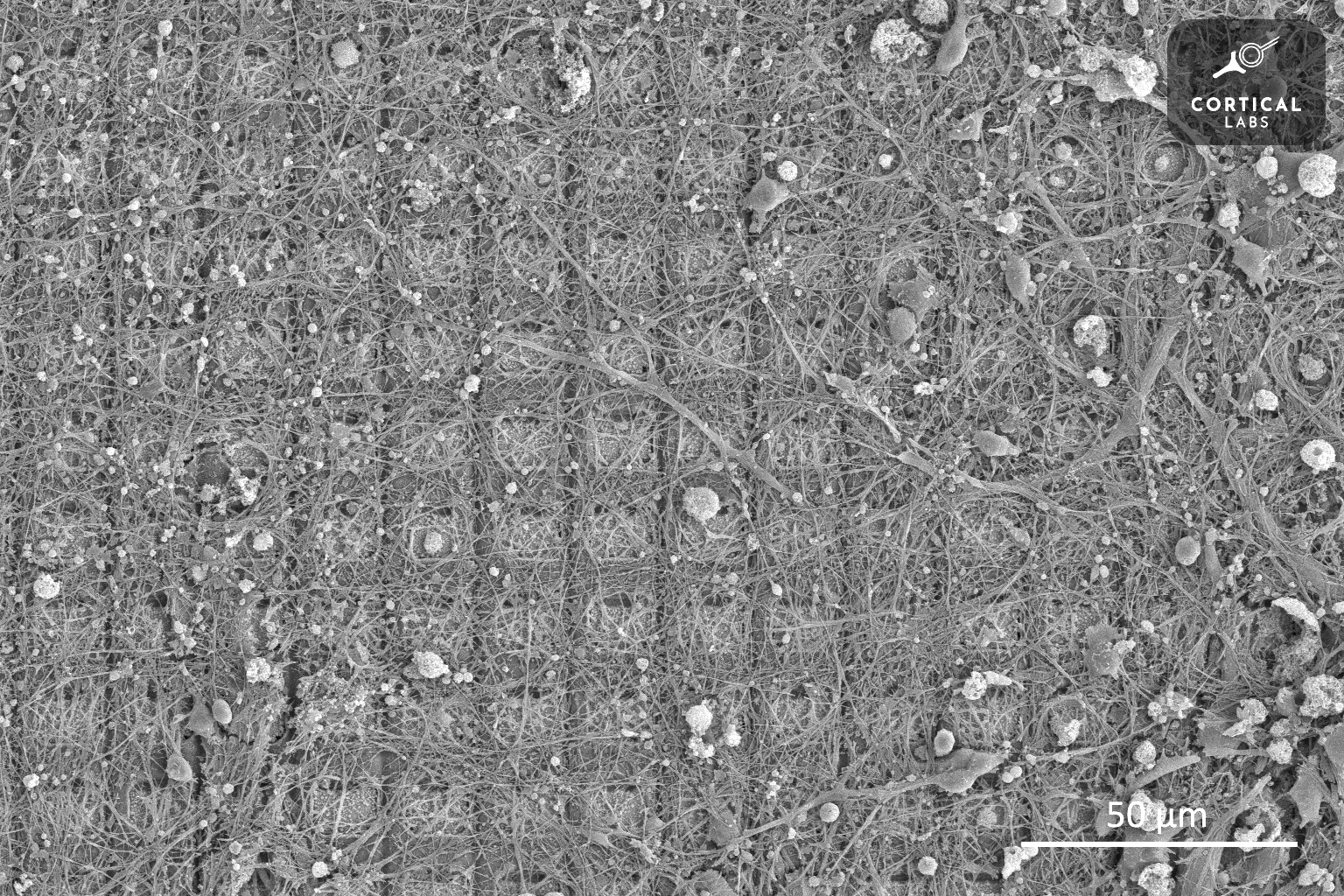

Scanning Electron Microscope image of a neural culture that has been growing for more than six months on MaxWell Biosystems high-density multi-electrode array. A few neural cells grow around the periphery and have developed complicated networks which cover the electrodes in the centre: https://bit.ly/3SETttG, credit Cortical Labs
Can you explain how you came up with the concept and what are the strengths and limitations of our system to carry out this research? What should people look out for if they were to do something similar?
It was a collaborative effort on how to approach it. Dr. Hon Chong and Dr. Andrew Doherty, together with MaxWell Biosystems, originally wanted to do neurons on a chip, and then I came into the picture, focusing more on the design process. As I mentioned earlier, it was a team effort!”
When it came to using the system, I believe that the built Application Programming Interface (API) was particularly useful. It enabled Andrew to interact with it in real-time, and to a lesser extent, me as well.
Which specific feature(s) do you like most about our MaxOne product?
I really like that the HD-MEA surface is highly configurable in terms of what you’re reading or writing from. For samples such as organoids, it’s really helpful because it could be challenging to align them perfectly on a chip. However, this is not a problem with MaxWell Biosystems HD-MEA as you are able to choose which electrodes are on the chip with a very low pitch. So, I think that’s a brilliant feature to have!
Have there been any challenges and how did MaxWell Biosystems help to resolve them?
The support that MaxWell Biosystems provided, mainly to Andrew, was extremely helpful in terms of using the system. Although there were some initial issues , MaxWell Biosystems responded promptly once they became aware of the problem. This has been a significant improvement, and we appreciate the company’s responsiveness.
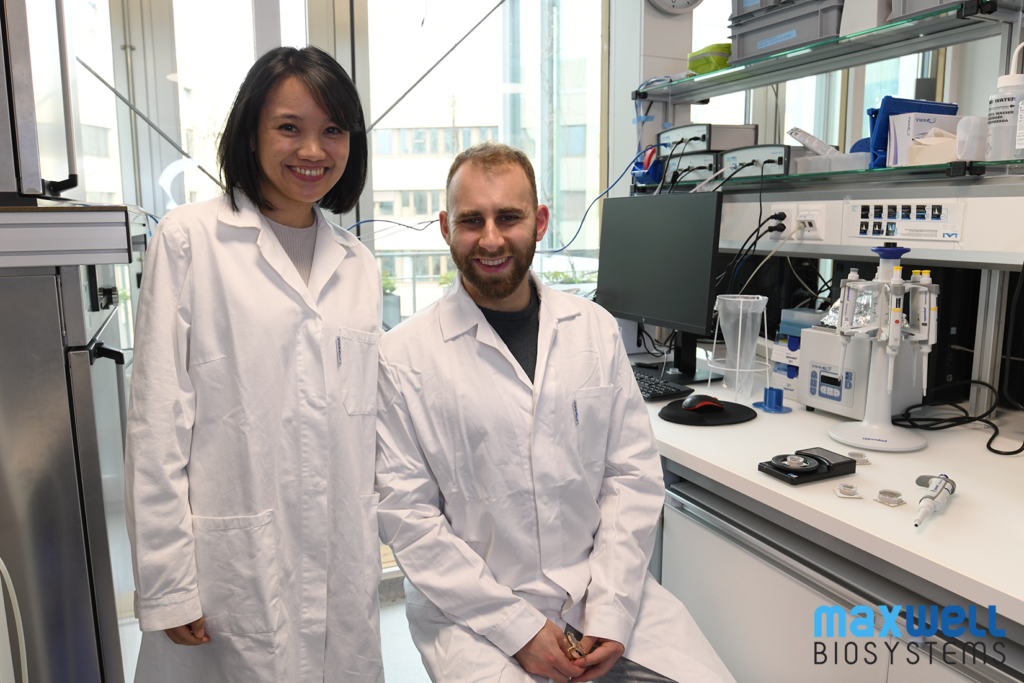

Marie Obien, CCO at MaxWell Biosystems and Brett Kagan, in the lab at MaxWell Biosystems, Switzerland
Looking at the paper, what is the major impact of your discovery of training cells to play pong. What are future applications and how will it lead to new studies?
So, it’s difficult to determine the real impact it will have. However, many individuals are enthusiastic, interested, and curious about it, which will hopefully encourage greater participation. I believe we have opened people’s eyes to what can be accomplished and highlighted potential applications. We would be pleased to see it utilized in areas such as toxicology, drug discovery, or screening, providing a functional measure of cognitive performance.
What is the response from the scientific community on this study?
It may take some time for the scientific community to fully embrace this technology, but it’s encouraging that few skeptical voices have challenged the scientific approach. The criticism often seems to be more about semantics than the actual research, which is a positive sign.
Again, it’s really hard to tell what people are going to use it for. But I think in the short term, in the next two to three to five years, definitely drug discovery, disease modeling, and understanding how cells work. And then that can have applications maybe to machine learning or neuromorphic or others.
In the long term, we think that there is a role for a system that can learn in real-time. High sample efficiency would be perfect for real-time robotics or autonomous systems that interact in a dynamic environment because biology, at its core, is the only thing that’s led to generalized intelligence.
And if you’re going to have something that requires this level of generalized intelligence, the only ground truth we have is that the only way we know it can be done so far is with biology. Maybe people will discover some secret quantum or secret machine learning algorithm that no one has ever come across and make some huge strides. I don’t know how likely that is. If it doesn’t, maybe biology will be a good answer.
What would be the requirements, do you think, to be able to enable these technologies to be developed in the future in terms of capabilities?
There are three key technologies required to improve the capability and viability of this technology. First, would be software. We need to develop better algorithms to be able to interact with the systems quicker and process the data in real-time in more complicated ways that have more meaning and nuance.
The second is hardware. The MaxWell Biosystems hardware, for example, is really good at reading. However, we also need to be able to deliver more complex stimulation to the cells, which will always be a challenge. We need to figure out how to encode that information and interact with it in a viable manner.
Thirdly, the wetware or synthetic biology or biological cell culture approach is crucial. We need to build up these networks of neurons into more complex structures with more specific cell types, and this will be really important.
What is coming next? What is the next big step?
It is tough to predict what the next big step will be, but it will likely involve more specific cell types. Currently, we use quite general approaches, but in the future, we can be more intentional about that or use more complex cell types that bring together different features. For example, in our study, we didn’t use hippocampal cells, which are helpful for memory. So, maybe introducing hippocampal cells or place coding cells could lead to more memory.
Another possibility is to move to 3D cell cultures with the same cells but higher complexity in the connections. This is an area that will be interesting to explore, as it may require different hardware to capture and integrate with 3D structures.
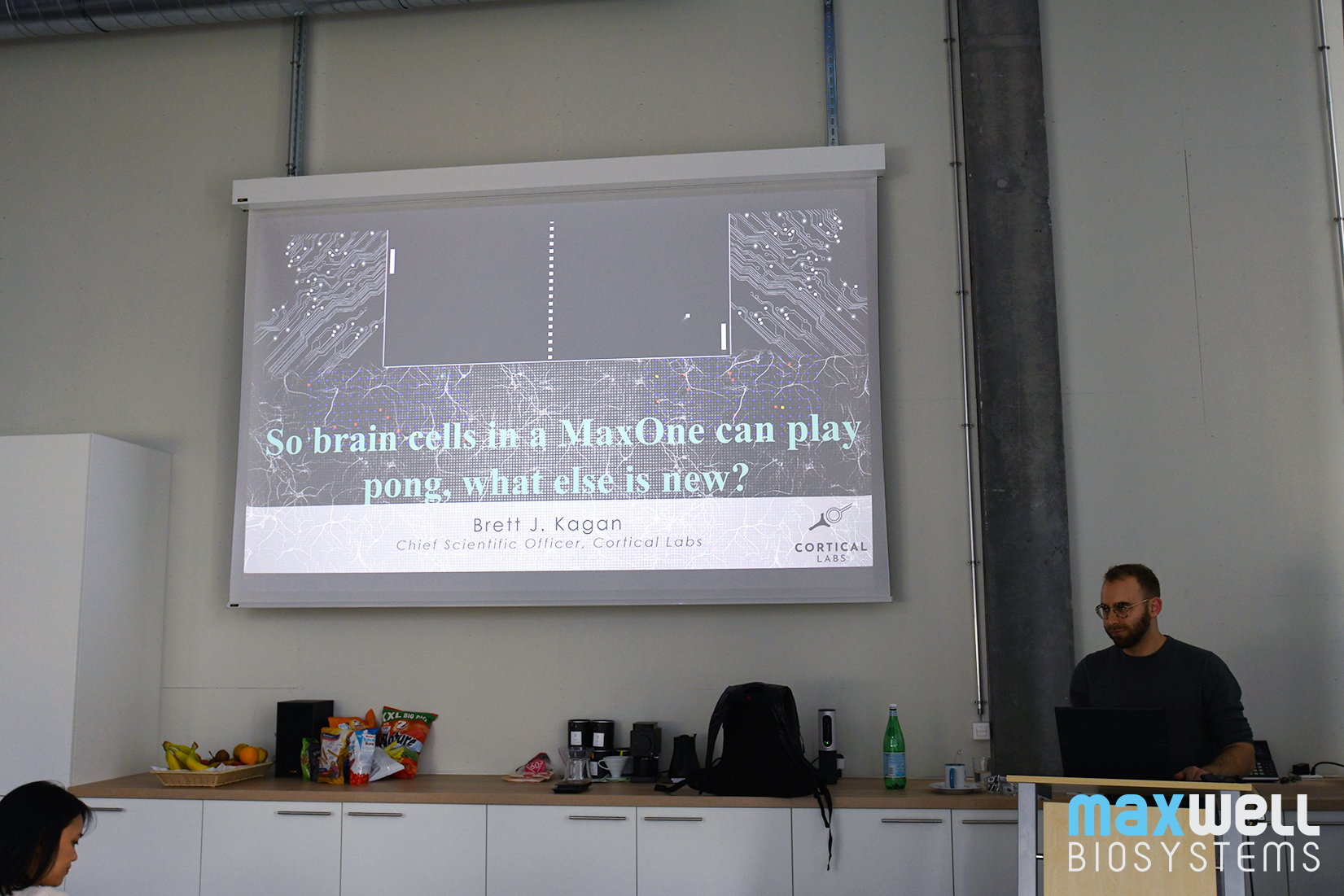

Brett Kagan’s seminar titled “So brain cells in a MaxOne can play pong, what else is new?” at MaxWell Biosystems, Switzerland
Do you have any new hardware related developments around the system?
Yes, and I find it really exciting to think about all the potential avenues for exploration. When we consider the original work, the prototype itself is what’s really exciting. I like to use the phrase “innovation through synthesis” to describe it, though I can’t recall where I first heard it.
For instance, if we didn’t have the appropriate algorithms, software languages, and modules, we would have had a hard time putting it together. Likewise, if MaxWell Biosystems hadn’t developed such a flexible system, we would have faced difficulties. And if there hadn’t been significant progress in synthetic biology and cell culture over the past decade, we would have faced enormous challenges. Therefore, I believe it’s the combination of these three factors that allowed this project to succeed and yield such an interesting outcome.
We’re very grateful for the assistance that MaxWell Biosystems provided and for their ongoing support. They’ve been a fantastic team to work with, and their interactive support has been much appreciated. Some companies would have simply said, “You bought the product, you’re on your own,” but MaxWell Biosystems didn’t, continuing to provide top-tier support, and we’re grateful for it.
Finally, do you have hobbies you would like to share with our readers?
Yes, I do have hobbies that were indeed affected by the COVID-19 pandemic and some extra work that tried to “kill” them, but I do enjoy hiking, bouldering, and staying active. And also, I do have two high-maintenance cats that require my attention and time.
Thank you so much Brett for all your input and feedback! It is great to hear about your success and again, we are thrilled to also be part of the story! Looking forward to what might come next!
Thank you so much for your questions and conversation. As I said, I am happy to collaborate as MaxWell Biosystems has always been really supportive which, I really do appreciate! Talk to you again soon!
Short Bio
Dr Brett J. Kagan is the Chief Scientific Officer for Cortical Labs and has led the development of the DishBrain project, establishing the first real-time synthetic biological intelligence system. Having completed a PhD focusing on stem cell therapy before undertaking a Postdoctoral Fellowship in regenerative medicine and bioinformatics, Dr Kagan’s work now focuses on leveraging a variety of cross-disciplinary methods to investigate the fundamental basis for intelligence in biological neurons.
Recent Publications


In vitro neurons learn and exhibit sentience when embodied in a simulated game-world
Brett J Kagan, Andy C Kitchen, Nhi T Tran, Forough Habibollahi, Moein Khajehnejad, Bradyn J Parker, Anjali Bhat, Ben Rollo, Adeel Razi and Karl J Friston. Neuron, October 2022
(DOI: https://doi.org/10.1016/j.neuron.2022.09.001)
Thank You
Discover More
If you would like to learn more about Brett’s work with our HD-MEA systems, watch his presentation at the 2nd In Vitro 2D & 3D Neuronal Networks Summit, 2022.
Our Application Scientists are more than ready to answer your questions about our HD-MEA technology and applications and how it can elevate your research. If you would like learn more please contact us through email via info@mxwbio.com or schedule a discovery call below with one of our Application Scientists.
  |   |
 English
English



